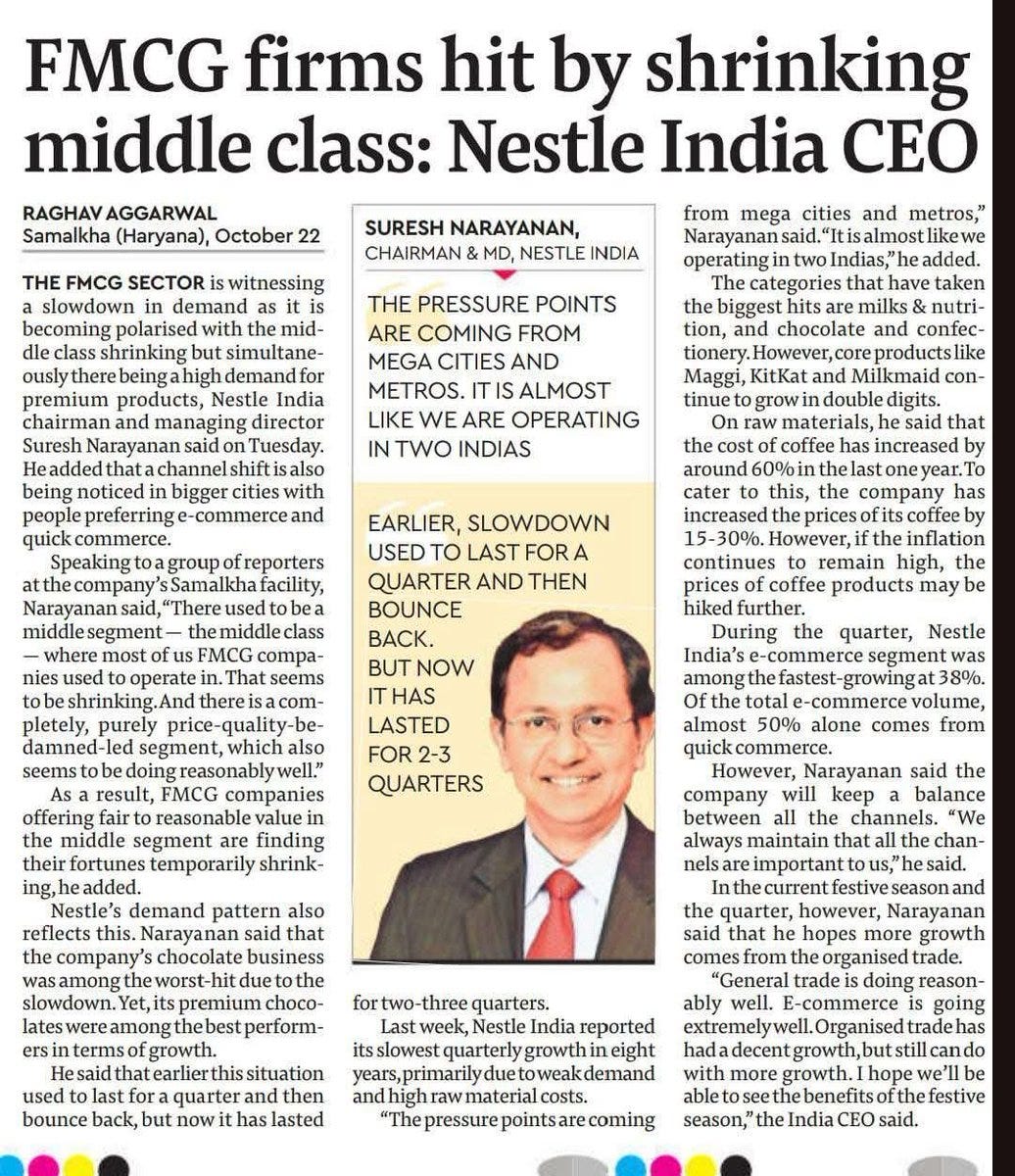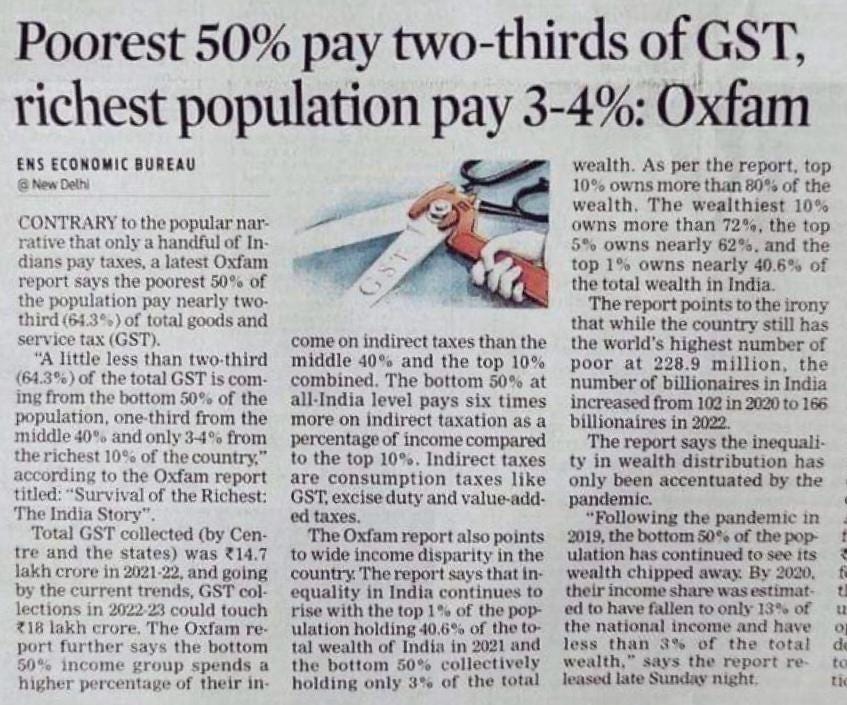India's Vanishing Middle Class: Phenomenon and Implications
CEO of Nestlé India's Frank Comments Raise Concerns and Red Flags.
CEO of Nestlé India's Comments Stir Debate
The middle class, long regarded as the engine of India's economic growth, is now under strain, with its very existence being questioned. Suresh Narayanan, Chairman and Managing Director of Nestlé India, recently raised red flags over the shrinking middle class, particularly in the context of the fast-moving consumer goods (FMCG) sector. His remarks, grounded in firsthand observations of demand patterns and consumer behaviour, come at a time when economic inequalities are becoming more pronounced. Nestlé’s experience reflects a broader challenge that threatens not only businesses but the very fabric of India’s economic growth.
Shrinking Middle Class and Changing Demand Patterns
The middle class has traditionally been a crucial market for FMCG companies, representing a stable and reliable consumer base for everyday goods. However, this once secure demographic is shrinking, creating significant shifts in consumer demand. According to Narayanan, demand is polarising, with a noticeable rise in the consumption of premium products in larger cities, while the demand for middle-tier products is fading. Consumers at the lower end of the income spectrum continue to buy essentials, while wealthier consumers increasingly seek premium offerings.
For Nestlé, while core products such as Maggi noodles and KitKat chocolates remain in high demand, there has been a decline in discretionary spending on indulgent products like chocolates, which tend to suffer when disposable incomes are squeezed. This trend is alarming for the FMCG sector, which has thrived on catering to middle-income consumers, a segment that now appears to be eroding.
Rising Costs and Price Pressures
Inflationary pressures have further compounded the difficulties faced by the middle class. The rising costs of raw materials, such as coffee, have forced companies like Nestlé to increase prices, passing on the burden to consumers. The impact is twofold: while premium products continue to sell among wealthier consumers, the middle class, already facing stagnant wages and reduced purchasing power, is feeling the pinch more acutely. Narayanan highlighted that these price hikes, while necessary for businesses to maintain margins, have contributed to the decline in demand for certain products traditionally popular with middle-income households.
E-Commerce: A Boon for Urban Markets
Despite these challenges, there is a silver lining in the form of digital commerce. The rapid growth of e-commerce and quick commerce (same-day delivery services) is reshaping consumer behaviour, particularly in urban centres. Nestlé’s e-commerce segment has seen significant growth, with nearly half of this expansion driven by quick commerce platforms. This shift towards online shopping reflects the changing dynamics of consumption in India’s cities, where convenience is becoming a key driver for premium product sales.
However, this shift predominantly benefits the more affluent consumers, who have greater access to digital platforms and the disposable income to afford quick commerce. The shrinking middle class, especially in smaller towns and rural areas, may not be in a position to fully participate in this digital economy, further widening the economic divide.
Longer Economic Slowdowns: A New Reality?
Narayanan’s observations also hint at a broader concern: the length and severity of economic slowdowns in India are becoming more protracted. Whereas earlier economic downturns were relatively short-lived, the current economic environment is marked by prolonged periods of stagnation. This exacerbates the challenges for businesses, particularly those relying on middle-class consumers whose incomes have not kept pace with inflation and rising living costs. A shrinking middle class means fewer customers with disposable incomes, potentially leading to slower growth for industries that depend on mass consumption.
Implications for Policymakers and the Economy
The disappearance of the middle class has profound implications for India’s economic stability. A thriving middle class is not just essential for sustaining consumer-driven industries but also serves as a buffer against economic inequality. Without a robust middle-income segment, India risks becoming a more economically divided society, where the benefits of growth are concentrated in the hands of a few, while a significant portion of the population struggles to meet basic needs.
1. Exacerbating Economic Disparity
The erosion of the middle class could deepen economic inequality, creating a stark divide between those who can afford premium products and those who cannot. This polarisation could have long-term consequences, leading to reduced social mobility and increased tensions between different economic groups. If unchecked, this disparity could destabilise the political and social fabric of the nation, as has been seen in other countries where the middle class has eroded.
2. Impact on Consumer Spending
A shrinking middle class also means reduced consumer spending in key sectors. FMCG companies, which once thrived by targeting middle-income households, may struggle to find growth in a market that is becoming increasingly divided. As consumption patterns shift towards either premium products or essentials, industries dependent on middle-tier products may face stagnation or decline, further hampering economic growth.
3. Policy Interventions
To address this growing concern, policymakers will need to focus on measures that promote income growth and job creation, particularly in sectors that cater to the middle class. Investing in education, healthcare, and infrastructure could help create a more resilient and economically diverse middle-income segment. Additionally, managing inflation and ensuring that essential goods remain affordable for all segments of society will be critical in maintaining economic stability.
Challenges for the Political Executive
The concerns raised by Narayanan are a wake-up call for India’s political leadership. To prevent further erosion of the middle class, the government must implement policies that ensure inclusive growth and support job creation across all sectors.
Job Creation and Economic Opportunities: One of the primary ways to revive the middle class is through large-scale job creation. Investments in manufacturing, digital infrastructure, and services will be key to generating employment opportunities that provide stable incomes.
Investing in Digital Infrastructure: The rapid growth of e-commerce presents an opportunity, but to fully leverage this, the government must continue to invest in digital infrastructure that extends beyond urban centres to smaller towns and rural areas. Ensuring equitable access to the digital economy could help mitigate some of the economic divide.
Addressing Inflation: High inflation disproportionately impacts middle- and lower-income groups. The government and the Reserve Bank of India must work in tandem to manage inflation through fiscal and monetary measures, ensuring that essential goods remain affordable for all.
Regressive Taxation: A Compounding Factor in Middle-Class Struggles
A recent Oxfam study highlights a troubling imbalance in India's tax structure, revealing that the poorest 50% of the population bear nearly two-thirds of the total Goods and Services Tax (GST), while the richest 10% contribute a mere 3-4%. This stark disparity underlines the regressive nature of the GST, which disproportionately burdens the middle and lower-middle classes. As an indirect tax, GST is levied uniformly on all consumers, including farmers, regardless of their income levels, making it particularly harsh on those with lower earnings.
This issue is further aggravated by India's unique tax environment, where corporate income tax rates are set lower than the highest individual income tax brackets. Such a system not only places additional strain on middle-income earners but also widens the gap between the wealthy and the rest. For a country grappling with a shrinking middle class, this calls for urgent tax reforms to ensure a more equitable distribution of the tax burden. A recalibration of the tax system is essential to promote fairness, restore economic balance, and alleviate the mounting pressure on the middle class, whose stability is vital for India’s economic future.
Conclusion: A Call to Action
Had these comments come from political leaders, aligned think tanks, or armchair economists, they might have been dismissed as off-the-cuff remarks or politically motivated rhetoric. However, coming from the CEO of a major multinational corporation like Nestlé India, these concerns should serve as a wake-up call for all stakeholders — the political executive, bureaucrats, industry leaders, and the Reserve Bank of India.
The vanishing middle class is not just a business challenge; it is a national concern that requires immediate attention. Failure to address this issue could lead to a more divided society, where economic opportunities are limited to the privileged few, while the majority struggles to make ends meet. This is a moment of reckoning for India's policymakers and industry leaders alike — one that demands swift, decisive action.







